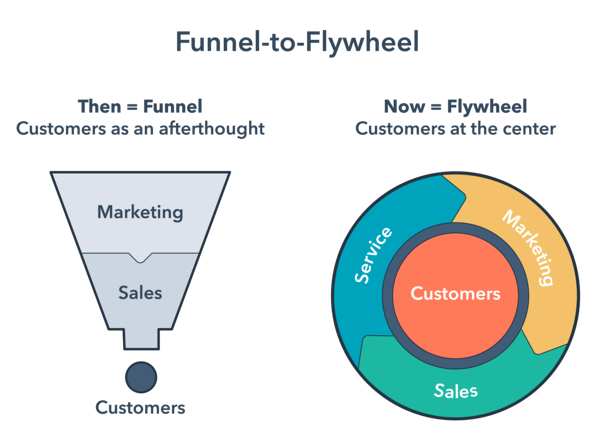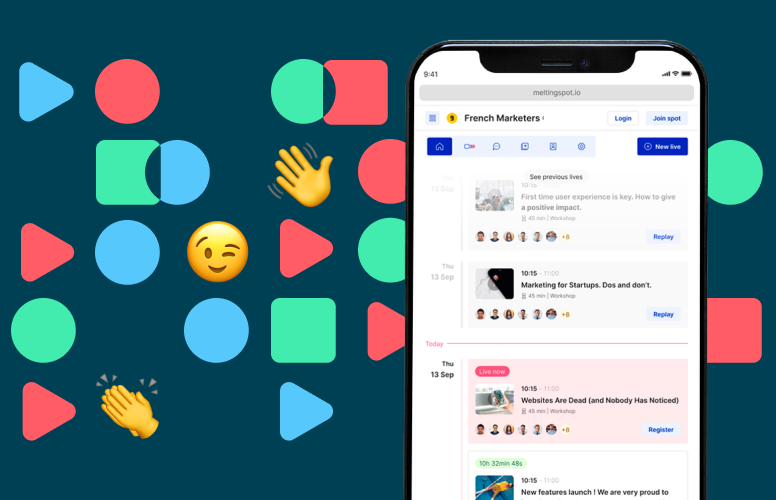In 2022, community is the cornerstone of successful businesses. Community-Led Growth is when a community is built and led by the company, in order to drive its growth.
This is especially true for communities of prospects. These communities are true gold mines of opportunities to turn leads into customers, boost conversion, and build allies.
In this article, MeltingSpot gives you an overview of the best growth strategies to turn prospects into customers. With a focus on SQL, PQL... and especially CQL strategies
Community-Led Growth: the community as an engine of growth
Community-Led Growth is a growth strategy that originated in the United States. This concept is based on the idea that a community is an asset for companies, and directly impacts their growth and development.
When the community is placed at the center of the company's strategies and concerns, it becomes a driver. This approach is based on a "Flywheel" concept: rather than placing prospects or customers at the end of the funnel, they are now integrated into the heart of the process. The communities feed a "wheel", which turns and moves forward thanks to the strength of the engine at its center: the community.
Let's take the example of an engaged prospect community, like the one of CFO Connect (Spendesk). This B2B community brings together financial decision-makers, most of whom are prospects of the Spendesk company. By offering a community experience based on mutual support, content sharing, and event organization, the company's growth is directly impacted:
✅ Closing rate is 3 times higher for community customers (vs. non-member customers).
✅ Retention is 18% higher for customers who belong to the community.
✅ The number of contracts signed is 35% higher in the community, compared to the number of contracts signed via other channels.
Thus a community is a lever of business opportunities, with a considerable return on investment (ROI). But it's not the only strategy to turn prospects into customers!

SQL, PQL, CQL: 3 growth strategies to know
Today, different strategies coexist to acquire customers and accelerate the development of a company. Ready for an overview?
Sales-Qualified Leads (SQL) Strategy
This strategy is based on a "Sales-Led" approach. Here, the sales teams lead the operations and seek to influence growth. The stages of the buying cycle are as follows:
- Leads: leads that show an interest in your products, services, or company
- MQL: these leads are qualified by marketing teams. They are called Marketing-Qualified Leads (MQL). The profile, needs, and behavior of these leads are validated by the marketing department: and they can be passed on to the sales team.
- SQL: the sales teams then try to transform the MQL into SQL (Sales-Qualified Leads). This is the next phase of the sales cycle, which consists of guiding the qualified lead to a purchase. The criteria for qualification by the sales team are based on budget, authority, need, and project timeline...
To ease this transformation into SQL, teams can rely on e-mail nurturing. Behavioral analysis (opening emails, return rate, downloading content located further down the conversion funnel...) helps define the right moment to propose to the SQL to meet a sales representative, create an account or get a demo... Until they become a customer!
Product-Qualified Leads (PQL) strategy
To boost acquisition and growth, another strategy is interesting: Product-Qualified Leads (PQL).
A PQL is a prospect or customer who uses a product or service through a trial offer or a freemium model... And who shows interest in moving up to a premium offer, in order to become a regular or loyal customer.
Here, the challenge is to propose a product that is convincing enough to make the lead convert. It is the lead's experience with the product (via a self-service onboarding or thanks to a Customer Success Manager) that will then dictate their behavior. We talk about aiming for the "aha moment": that key moment when the prospect understands the added value of a solution... And cannot do without it.
To illustrate this PQL strategy, the best example is Slack. Users can use the platform freely up to a certain limit. From 2,000 messages sent, the platform considers users as PQLs (product-qualified prospects). A more elaborate paid version is then offered to them.
🚀 According to Wes Bush (Product Led strategy expert), in the B2B SaaS industry, 20-30% of PQLs convert, with this strategy!
Community-Qualified Leads (CQL) Strategy
Unlike the previous two strategies, it is not the validation of the business team or the adoption of a product that defines a CQL. It's the community.
A Community-Qualified Lead (CQL) is a lead that emerges from your community. Their first point of contact is not the sales or marketing team, but the community set up by the company. By joining a community of prospects, these leads gain experience and value, and they naturally enter the sales funnel.
By analyzing the interactions and the participation of community members, companies can identify the most engaged prospects. In this case, it's not the brand or product that educates the lead, but the community they belong to.
🔄 This strategy joins Hubspot's flywheel concept: the funnel model is replaced by a virtuous wheel. Prospects (and future customers) are no longer placed at the end of the funnel but at the center of concern. And by spreading this culture of Community-Led Growth, all departments benefit from the advantages of an engaged community!

Community-Qualified Leads (CQL): why choose this strategy?
Today, Community-Qualified Leads strategies strengthen Sales and Product strategies. Thanks to Community-Led Growth, the prospect experience includes more interaction and collective intelligence.
And the good news is that this approach perfectly meets the new expectations of prospects: no longer simply buying a product, but living a complete experience, based on sharing and co-construction. Purely transactional behaviors are replaced by emotional and experiential ones.
Now, creating, animating, and engaging a community offers many opportunities. It is a new step in the buying process, which reinforces the attachment to brands. Today and in the future, with a CQL approach, the Human is put back in the center: leads are not simply sent in conversion tunnels (without transition), after an exchange on social networks or the download of marketing content.
On the contrary, the community encourages sharing, mutual aid, questions to inform oneself, participation in co-construction actions... And reassurance does not come (only) from a brand and its products. The real lever is peer-to-peer exchanges, within a community that drives growth and transformation.
💡 Does Community-Led Growth, community building, and this CQL strategy speak to you? At MeltingSpot, we've made it our core business. Discover now our community platform, to manage your different communities 👇

Become a Digital Customer Success Champion with MeltingSpot Academy!
Step into MeltingSpot Academy, your ultimate training hub for mastering Digital Customer Success. Level up your skills and become an expert in customer onboarding and education. Join a community of passionate CS leaders who are mastering the latest tools and strategies, including MeltingSpot and other top solutions. Get access to exclusive courses, masterclasses, inspiring talks, eBooks, and more to boost your expertise and lead the way!
Join Academy






